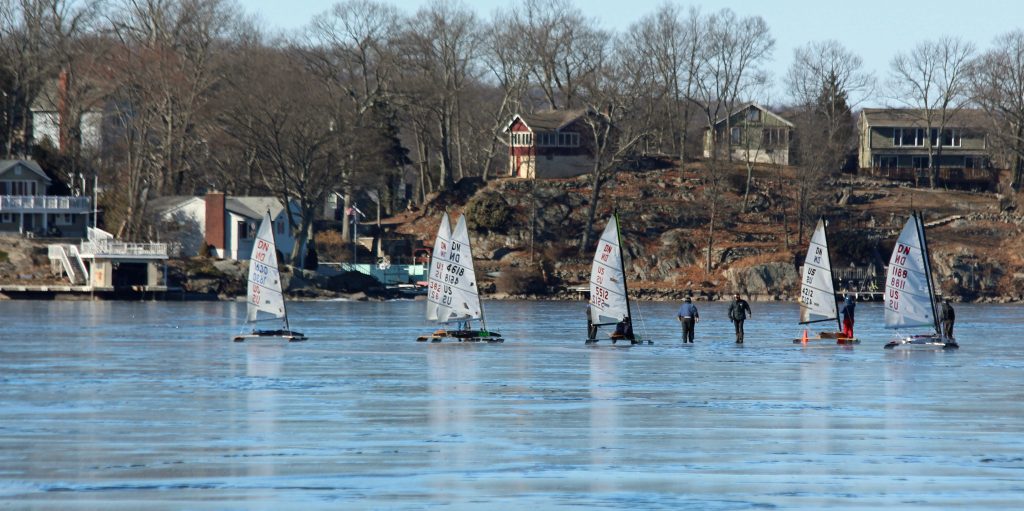
Is Lake Hopatcong more fun in the summer or the winter? The answer depends on who you ask. While this question might set your mind adrift to sunny days floating in the lake, for others ice hockey and hot cocoa come to mind. Personal opinions aside, it’s important to keep Lake Hopatcong a safe place to recreate any time of year.
The idea of protecting in-lake structures from ice damage is not a new one. First introduced in the 1960’s, bubbler systems were meant to maintain a small area of open water along structures to protect against heaving and shifting ice. In recent years the arrival of more powerful propeller driven systems combined with warmer winter temperatures have increased the amount of open water on Lake Hopatcong. The decision to maintain open water should be preceded with care and consideration for the safety of all lake users and the health of the lake itself.
While the protection of one’s property is important, de-icing devices have associated negative impacts as well, including;
- Promotion of algae and weed growth through the alteration of water temperature and light conditions. When allowed to freeze over, ice blocks sunlight from reaching the lake bottom and reduces weed and algae growth.
- Maintaining an open area of water raises safety and liability implications for property owners. In the unfortunate case of an accident, the risk of liability exposure and a potential lawsuit falls on the property owner.
- Open areas of water can increase the risk of dock damage by allowing ice floes more room to accelerate toward shorelines.
- Disturbing bottom sediments can release nutrients such as phosphorus which results in increased algae growth.
- Areas of open water reduce or eliminate winter recreation opportunities.
- Ice retardant systems are expensive to buy and operate and they do not guarantee less ice damage.
- Propeller driven systems have been banned on other lakes and there is a possibility that the State may take similar action in the future on Lake Hopatcong.
Before You Purchase – Is the Device is Capable of Meeting Municipal Regulations?
Before purchasing a device, it is important to consider whether it is capable operating within municipal requirements, which are meant to limit areas of open water. Regardless of which municipality you reside in the following regulations are consistent around Lake Hopatcong;
- All ice-retardant systems shall be marked with an appropriate sign placed along the shore or on the protected structure specifying “Danger, Thin Ice.” Such sign shall be a minimum of two feet by three feet in size and shall feature letters of a minimum height of three inches and colors in such a way as to be clearly visible on the ice from a distance of 100 feet. Where the ice-retardant system will disturb a distance measured horizontally along the shoreline of more than 25 feet, an additional sign shall be required for each 25 feet of shoreline or fraction thereof.
- Under normal operation conditions, the affected area of ice created by the ice-retardant system shall not extend more than 25 feet beyond the protected structure.
- Under normal operation conditions, the affected area of ice created by the ice-retardant system shall not extend more than 25 feet, measured along the shoreline, from the protected structure.
- Irrespective of the standard appearing in Subsections Band C above, the affected area of ice, under normal operating conditions, should not extend to within 10 feet of a side property line. Said requirement may be waived if the owner and/or operator of the ice-retardant system obtains written permission from the adjacent property owner.
- Unless the ice-retardant system has been designed and approved in accordance with § 137-6of this chapter, no system shall be designed or operated in such a way as to prevent ingress or egress to any portion of the water body or to foreclose the formation of ice across a channel.
Types of Ice Retardant Systems
There are two principal types of systems available for purchase today. Bubbler systems use an air compressor to force air through a weighted, perforated line in the water. The resulting air bubbles agitate the water and maintain an open channel along waterfront structures that prevent heaving and shifting ice from causing property damage. The alternative is a propeller driven system, which have gained popularity in more recent years. These systems use a propeller to draw warmer bottom waters to the surface while simultaneously agitating water to prevent ice formation.
Generally, propeller driven systems are more powerful than bubbler systems, which means that they often require more frequent observation to ensure compliance with local ordinances. Proper installation of either system requires monitoring and adjustment. ALL ice retardant systems should be operated with a timer to limit run-time to 15 minutes per half-hour at night and 15 minutes per hour during the day. A thermostat is equally important and should be used to prevent systems running at temperatures above 32 degrees Fahrenheit.
Guidelines for Safe Operation of Ice Retardant Systems
The Lake Hopatcong Commission has provided the following recommendations for the safe and effective use of ice retardant systems in Lake Hopatcong.
- Select an ice retardant system that will maintain the smallest necessary area of open water around your lakefront structure(s).
- Use a thermostat to run the system only when air temperatures drop below freezing and a timer to limit run time to between 2-5 hours each day.
- Position your device to direct water vertically toward the surface rather than at an angle toward the middle of the lake or toward lake sediments. This will reduce formation of dangerous thin ice and minimize disturbance of nutrient laden sediment.
- When your dock needs to be replaced, consider installing a removable or cantilever style dock. These types of docks do not require use of an ice retardant system

